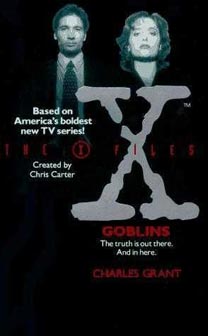With “The X-Files” returning for the start of a six-episode miniseries tonight, I thought it’d be a good time to go on an “X-Files” kick. Having already done reviews of the nine TV seasons and two movies, that means it’s time to move on to other media, starting with Charles Grant’s “Goblins” (1994), the first of six original licensed novels “based on America’s boldest new TV series.” (My reviews of these novels will include spoilers, because hey, you’ve had two decades to read them.)
“Goblins” is an effective novel if you aren’t being too picky. It works as a Sherlock Holmes-style mystery, with several scenes of Mulder, Scully and two accompanying agents – the male Webber, who idolizes Mulder, and the female Andrews, on her first assignment – discussing theories about the case. Set near Fort Dix in New Jersey (the home state of the author, who died in 2006), “Goblins” features a villain who takes on an all-black, near-invisible form to kill people at night.
There’s seemingly no good reason for Mulder and Scully to be grouped with another pair of partners, and for most of the novel I was unsure if that was part of the mystery or a miscalculation by Grant. (As “The X-Files” moved forward, Mulder and Scully almost always worked cases as a duo.) Thankfully, it turns out to be the former: Andrews is a plant of a new assistant director named Douglas, who has temporarily taken over for Skinner (who isn’t mentioned in the book).
The novel is set in early Season 2, after the X-Files have been reopened but before Scully’s abduction. Grant’s feel for “The X-Files” is quite a bit off considering what the show would eventually become, but it’s even off base by the standards of those early days.
Jarringly, Mulder resists taking on both this case and a Louisiana-based case that Douglas pitches to him, about a killer who seemingly disappears. Mulder doesn’t want the X-Files to be shut down again, so he’s hesitant to pursue cases that he can’t close. This is of course counterintuitive, as X-Files cases are difficult to close by their very nature; still, it’s somewhat understandable. The problem is that Mulder never shows hesitance in the TV series.
Other details are off, too. While shooting wadded-up paper into wastepaper baskets in his office, Mulder misses regularly, which seems out of character. He has a longtime friend, a sports reporter named Carl Barelli. Mulder likes to hang out at a bar near his residence called Ripley’s, and he had dated a waitress named Trudy a couple times. Granted, Season 1 features a lot of old colleagues and old flames of both Mulder and Scully. It wasn’t until the series found its footing that it admitted Mulder and Scully were (aside from their mutual attachment) loners and workaholics.
In another oddity, Scully pitches a weird science theory, which Mulder then latches on to. Usually, it is Mulder who comes up with the solution. It is kind of refreshing that Scully is correct for once, but it undermines the notion that she holds on to her skepticism until Season 8. At least Grant adds some verisimilitude by having Scully think along the lines of “God help me, I’m starting to sound like Mulder.”

It’s understandable that Grant wanted to build up the universe of “The X-Files” with shifty AD Douglas (the TV series, after affirming that Skinner is a good guy, later featured double-dealing assistant directors as a trope, so Grant was ahead of the game here) and a home bar and ex-girlfriends for Mulder, while also fast-tracking Scully’s conversion to the Believer POV. Grant didn’t realize that fans would actually embrace the loner nature of the lead characters and their slow-burn arcs, and that the show’s deliberate pace would be seen as a feature, not a bug.
The plot of “Goblins” is shaky – I had trouble keeping all the characters straight at times, and Grant overdoes it in connecting everyone together (in addition to being Mulder’s friend, Carl is obsessed with Scully and is also a relative of one of the goblin’s victims) – and the solution doesn’t quite stick. The “goblin” is a police dispatcher who volunteers for a secret military science experiment that turns her into a chameleon (while also killing her). But she’s not able to control her changing skin color, so she uses makeup to cover it up. It seems unlikely such a strategy could hold up to close scrutiny. And her motive, as it turns out, is that she simply enjoys killing; something tying into her anger over the experiment’s failure might’ve added depth to the villain.
Grant’s writing style is what kept me churning through the 277-page paperback. He has a flair for noir, with curtains blowing in the breeze, hallways lit only by a couple harsh bulbs, and rain-shrouded streets. The fictional Marville, N.J., comes alive – so to speak – as a small town kept afloat by the proximity of Army and Air Force bases. Broadly, Grant paints the “X-Files” world; it’s only if you zoom in on the details that you see the flaws.
In this regard, the book is similar to several Season 1 and 2 episodes. But on the other hand, I – and many fans – find those early misfires endearing, because even if they haven’t found the characterization and plotting groove yet, they have a flair for exploring weird ideas. Chris Carter probably never read “Goblins,” and if he did, he’d likely reject it for not fitting with the feel of the show. Still, for die-hard fans, it’s fascinating to see how Grant tries to get a handle on a TV series that is still finding itself, sometimes guessing wrong in the process.

